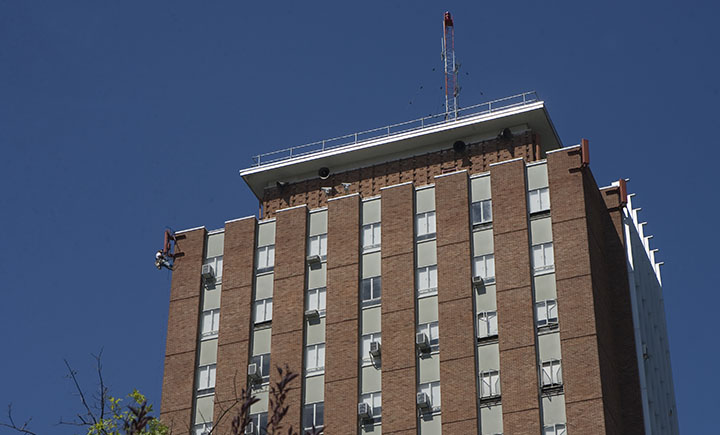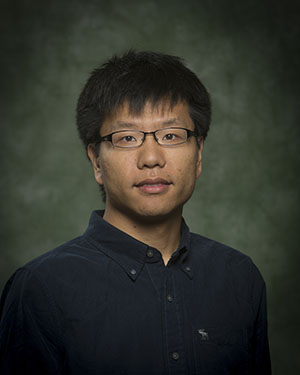Mobile data, privacy protection and spectrum access
Linke Guo received three separate grants from the National Science Foundation (NSF).

Assistant professor Linke Guo from the Electrical and Computer Engineer Department recently received three separate grants from the National Science Foundation (NSF) totaling over $600,000. All three research studies look at different problems relating to mobile phones, including data collection and signal improvement.
When you walk out the front door, that means going through that mental checklist of items you need to get through the day. It typically includes keys, a wallet and more often than not a cell phone. Mobile phones have become a necessity, but their ubiquitous nature has led engineers to two seemingly contradictory questions.
Using Cellular Data
The first is, can we utilize how connected everyone is to the benefit of society? Being able to access any person with a cell phone means that we can collect data like never before possible.
That’s where a practice called mobile crowd sensing comes in. Imagine a company like Uber being able to tell their drivers where most people are congregating on any typical Tuesday so those drivers can be ready. This information is accessible and can be collected through our cell phones.
Background noise can also be collected through mobile crowd sensing. During a massive emergency, responders might be able to find out where the most chaos is by taking note of where the noise level has increased.
For Guo, he sees the potential crowd sensing has for addressing public health issues. His study “Crowd in Action: Human-Centric Privacy-Preserving Data Analytics for Environmental Public Health” will look at what kind of data can be collected to help keep people healthy.
Guo explained, “Let’s say there’s an area where the air quality has changed for the worse. A group of people may start going to the hospital reporting similar symptoms, but there isn’t a systematic way to collect that information.” Because of healthcare privacy laws and various hospital choices, it may take a while before a trend is noticed.
Guo believes there is another way to spot these trends. “When people get sick, they tell others about it. My study plans to develop a system where we can monitor tweets, texts and other forms of communication to know when there’s a public health concern in a certain area.”
With this information, environmental changes can be spotted sooner so that fewer people end up suffering from the same symptoms.
Protecting Privacy
While figuring out ways to use this data is the first big question for researchers, it naturally leads to the second question. Can we protect people’s privacy from these data collection practices?
Crowd sensing can be helpful but do we really want every company to have access to where we are, what we tweet or what we hear in the background?
That’s where Guo’s second study comes into play. It’s called “Towards Privacy-Preserving Mobile Crowd Sensing: A Multi-Stage Solution.” The intention of the study is to find ways to protect an individual’s privacy while also providing the useful information that we can get from mobile crowd sensing.
“When it comes to mobile crowd sensing, there are three places where someone’s privacy can be compromised,” said Guo. “It starts with the individual servers, then the collection process and finally the data analysis. This study will look at how best to protect people at all three stages.”
Building stronger connections
Guo’s third NSF-funded study addresses the concern that none of this is possible without a strong cellular or Wi-Fi connection. It’s called “Malicious Behavior Detection in Hybrid Dynamic Spectrum Access.”
All wireless communication travels through the air via radio frequency or what’s called spectrum. The Federal Communications Commission (FCC) regulates what types of wireless communication can use certain parts of the spectrum. That way a TV broadcast won’t change anything about your cell phone’s data connection. The issue that Guo is looking at is that these restrictions don’t account for real-time changes in use or environment.
“There may be an hour where fewer people are using their phones than what has been allocated. We want to be able to use that information in real time to then allow for more spectrum use on other devices,” explained Guo.
This can also be helpful for areas that have a certain terrain that keeps signals from going through.
Guo explained, “A mountainous area may be allotted the same spectrum use as a flat area, but those signals aren’t getting through because the mountains block the airwaves.”
The study plans to find ways to monitor these blocked areas so that their unused spectrum access can be transfered to other areas that can receive the signals.
Together, all three studies plan to change the way technology is used with an eye toward protecting privacy and maximizing the data and spectrum access that we do have.

